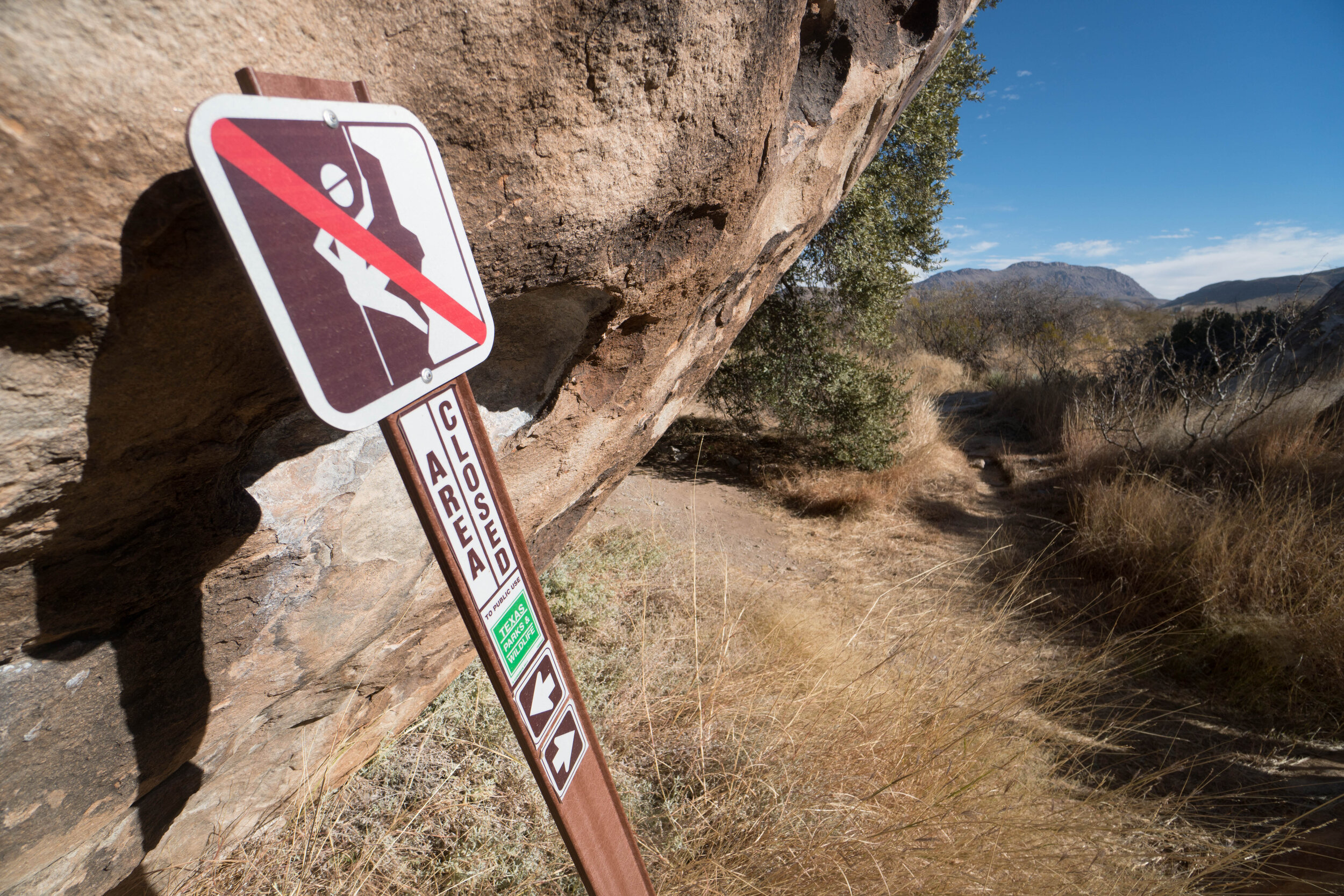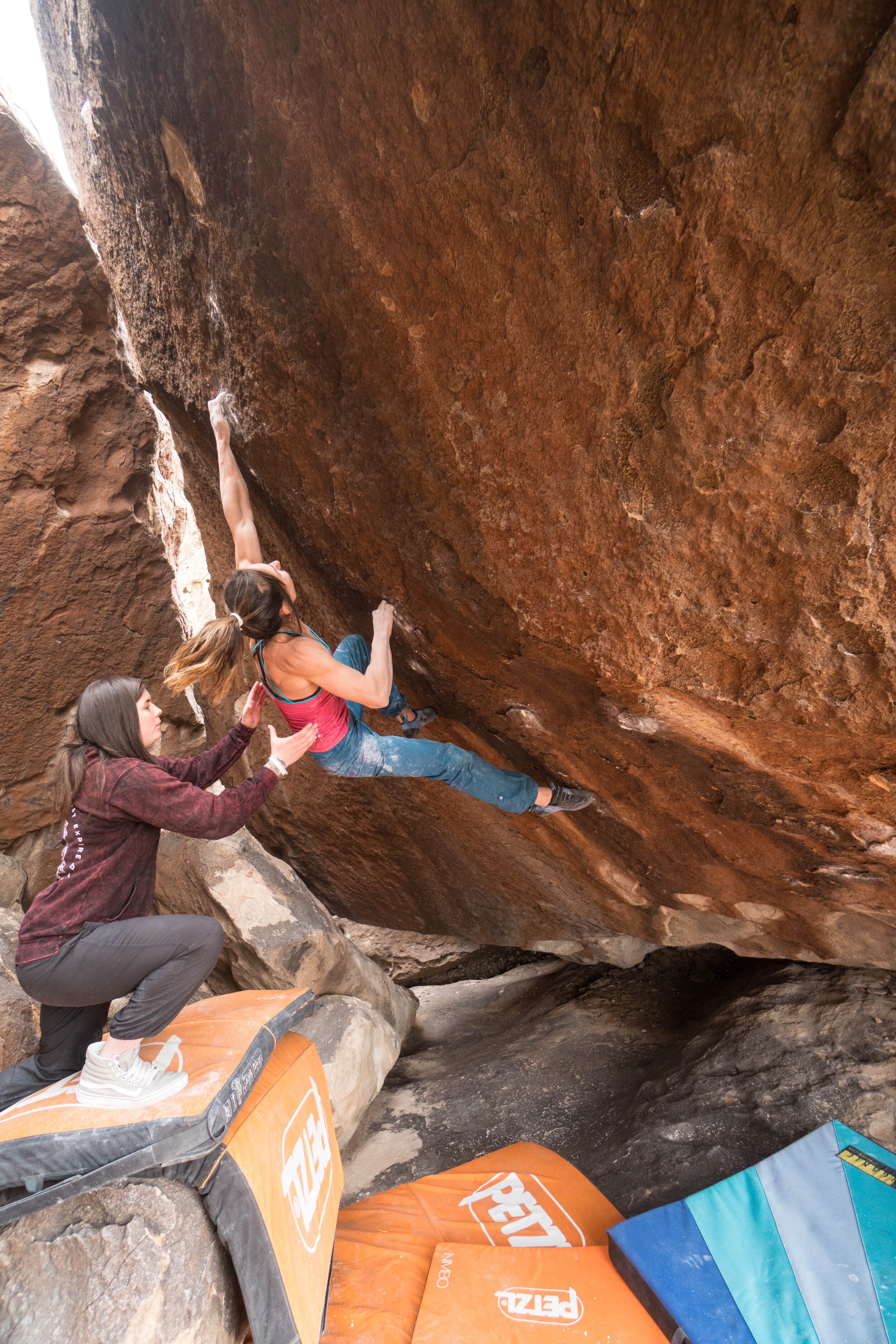When Legends Die
In December 2017, Pete Cimasi, a 39-year-old nurse anesthetist at the University Medical Center in El Paso, Texas, left the kneebar on an overhanging sport route on West Mountain at Hueco Tanks State Park & Historic Site. He traversed across the Eagle onto the formation’s exposed shoulder, following two widely spaced bolts up a 30-foot headwall. Cimasi came to the notorious Salsa Move, a 5.12 highstep off small, flat crimps five feet above the penultimate bolt. Earlier in the year, Cimasi had replaced the route’s 30-year-old rusty bolts with Wave glue-ins; still, the runout remained. Tapping his feet on the rock, Cimasi danced to the anchor to redpoint Todd Skinner’s When Legends Die (5.13b), one of the best routes of its grade in the US, and a line that hadn’t been repeated in 20 years.
Climbing activity on Hueco Tanks’ unique, featured syenite porphyry dates back to the 1950s with the Texas Western College (now UTEP) Kliff Climbers toproping at the area. In the second half of the decade, Royal Robbins and others established the first lead climbs, on the slabbier buttresses on the Front Side of North Mountain. In the mid-1970s, Tanks pioneer Mike Head, with John McCall and Mark Motes, established Indecent Exposure, a meandering Front Side 5.9+ that dances along the edge of a radically overhanging 300-foot buttress. Head and crew, along with the reclusive Bob Murray, also began exploring the area’s bouldering potential, with Head establishing the then cutting-edge Mushroom Roof (V8) in the early 1980s. John “Vermin” Sherman arrived in 1983, when he “had the boulders mostly to myself.” Sherman established over 400 classic problems at Hueco, including many of America’s early V9s—things like the roof crack Mother of the Future and the burnished slab Nachoman. When Skinner also showed up around then, he pushed steep, modern sport climbs.
Michaela Kiersch on Dragonfly (V5) Marina Inoue illustration
In 1987, when Skinner established Legends, the scene at Hueco differed greatly. Though bolting here was illegal until 1989, Skinner and company equipped at night, justifying it through a loophole in the rules. “The bolts themselves were legal,” Skinner was quoted as saying in Jeff Jackson’s article “Then and Now” in Climbing No. 195. “So if some unknown person got the bolts into the rock at night, then you could legally climb the route the next morning.” Using a muffled drill and lookouts, Skinner et al. established a number of climbs, including Legends. “[He’d just be] rubbing it into the rangers that, ‘Hey, look what I did, and you didn’t catch me,’” says Sherman of the neon quickdraws that hung throughout the winter while Skinner worked his projects. However, one bolter did get caught red-handed equipping East Mountain’s Tarts of Horsham (5.12+), a crimp marathon on the iron-rock Great Wall. “They make rules; we break em,” said Skinner. Predictably, this attitude led to problems, and for three weeks in 1988 the park banned roped climbing.
Keith Allen Peters on Westwood (V9) Marina Inoue illustration
Through the 1980s and into the 1990s, Hueco was considered a major destination for hard climbing. In 1991, Sherman published a bouldering guide including over 1,000 problems and introducing the V-Scale. His second edition, in 1995, catalogued 1,400 problems, including some of the hardest in North America—things like Crown of Aragorn (V13) and Martini Right (V12). By 1998, Fred Nicole had brought the first V14s to America with his Slashface and Coeur de Leon. As Hueco, a compact 860 acres, became an international nexus, impact issues began to arise on its three piles of steep, reddish-brown patina rocks: North, East, and West mountains. With less than 13 inches of rainfall per year and the majority of that coming in the monsoon season, the park was feeling the impact of increasing visitor numbers—the trampling of vegetation and the creation of social trails in the winter climbing season meant that the fragile Chihuahuan desert environs recovered slowly. With the additional impacts of chalk, boot rubber, and music, the situation was deteriorating quickly.
“There were 150,000 people [visiting] a year,” says former Park Superintendent Wanda Olszewski of the early 1990s boom, “which was definitely unsustainable.” Social trails braided through meadows. El Paso locals partied at the boulders, and litter and graffiti spread throughout the park. In 1992, the Tigua, the only Puebloan Native American tribe still in Texas, protested the Hueco Rock Rodeo, arguing that the area was sacred ground. (The tribe still uses the area for prayer and gatherings.) That same year, when graffiti including gang markings obscured rock art at the Kiva Cave, then Superintendent Darrell Rhyne announced that the park would close for two weeks. Hueco had hit a threshold.
Nina Williams on Guns of Navarone (V6)
Hueco Tanks’ history of human habitation dates back to 1150 AD, when the Jornada Mogollon people lived in the area, using the water that collected in the mountains’ large huecos (hollows/cisterns). They lived an agricultural lifestyle, but also painted the boulders with deer, masks, human-like faces including the Starry Eyed Man and the White Horned Dancer, and blocky, zigzagging depictions of Tlaloc, a rain god. From the mid-sixteenth to the mid-nineteenth century, other tribes added to the rock art, painting handprints, horses, snakes, and ceremonial dances. In 1898, Silvero Escontrias bought a large section of land, including what is today the park, from the State of Texas; the park remained in the Escontrias family until 1956, when Pilar Loya Escontrias sold off four sections containing the Tanks. The site passed through various hands, and at one point ended up with a developer who built a dam between North and West mountains, filled the basin with water, and attempted to sell lakeside property. Predictably, given all the fissures in the rock, the lake drained within days. In 1965, tired of seeing the park change hands and of the looting of archaeological resources, El Paso County bought the property. Four years later, the state took it over, opening it to the public in May 1970. Access would remain largely unrestricted for nearly 30 years.
In 1998, in response to the overusage crisis—to further protect the pictographs and restore impacted areas—the Texas Parks and Wildlife Department implemented the Public Use Plan (PUP). They created 70 slots per day that allowed climbers, hikers, birders, etc. to visit North Mountain unguided, with 60 of those slots reservable and the remaining 10 left for walk-ins. An additional 160 people per day could visit East Mountain, West Mountain, and the East Spur, but they needed to be accompanied by a Hueco Tanks–certified guide. Visitation rates dropped—according to “Then and Now,” the numbers fell from 85,000 in 1996 to 17,000 in 1999. Currently, approximately 30,000 people visit the park each year, with the same number of slots (70) open on North Mountain and little movement by the park to open it further.
Pete Cimasi on When Legends Die (5.13a)
“When I came to Hueco in the mid-90s, you couldn’t go to an area without there being two or three competing boom boxes, ” says Ty Foose, who will be co-authoring a new guidebook to the area. Foose, who lives directly across from North Mountain and has spent nearly 30 years climbing at Hueco, adds, “There were tons of people and 10 trails to go to any one boulder problem. And there was no wildlife.” While Hueco had offered the freedom to roam, quality rock, and plenty of future hard climbing, in the fragile desert that future had its limits.
In December 2017, on the east flank of West Mountain, Jason Kehl pulls out his iPhone, takes a photo of a tan swath of rock, and then applies the iDStretch app to it. Where there was seemingly only blank stone, the app picks up faint pigment, illuminating the lines until a colorful pattern emerges—artwork from a thousand years ago. The majority of Hueco’s rock art exists at ground level, where the mountains meet the desert. Over time, the pictographs have faded—although many, like the Starry Eyed Man and those in the Cave of Masks, are visible to the naked eye. In the past few years, park officials have used iDStretch to recognize and catalogue this less visible art, checking every boulder problem in Matt Wilder’s 2004 guidebook as well as other nearby sites. Not surprisingly, this has been problematic for climbers. Problems like Roughage (V7) and areas like the Warm-Up Boulder were closed a few years ago for rock art. Then, in February 2017, current Park Superintendent Ruben Ocampo closed an additional 29 bouldering sites (approximately 50 problems), including classics like North Mountain’s Adjust Your Attitude (V8) and East Mountain’s Belly of the Beast (V7), because of their proximity to rock art.
Jason Kehl using IDstretch
Many nonclimbing locals support the closures. “How can we respect the beliefs and sites of the indigenous peoples of this land while we continue to allow climbing at Hueco Tanks?” wrote Marilyn Rose Guida, a volunteer at the El Paso Archaeology Museum, in a March 2017 letter to the El Paso Times. While there remain lingering tensions between Hueco advocates who want to preserve the park’s history at any cost and Hueco climbers who want to climb everywhere, “There shouldn’t be a whole lot more closures,” says Sarah Ontiveros, treasurer of the Climbers of Hueco Tanks Coalition (CHTC), a local nonprofit climber organization. “There’s not going to be new rock art.”
In a positive development, some formerly closed areas are now coming back online. In 2017, the park reopened East Mountain’s Five Bimbos area, thanks in part to the efforts of the CHTC. In 1996, the park closed the area due to trampling and social trails. The CHTC worked to restore the area, creating better trail markers, allowing the meadow to revive. They also created seed bombs, collecting native grasses and flowers and embedding them in clumps of mud that could then be tossed on restoration areas during the rainy season.
Since 2005, the CHTC has done a yearly cleanup. Shortly after the Rock Rodeo comp, 80–120 volunteers will walk through cleaning up micro-trash and glass shards from Hueco’s days as a party spot, and washing chalk off high-visibility areas. Further, the coalition has mitigated erosion in areas like the one around Nobody Here Gets Out Alive (V2), a much-traveled jug-roof on North Mountain, hiking bags of sand and soil to reinforce the landing. Still, climbers have had to live with the December 2007 Mushroom Boulder closure, imposed because of erosion and the subsequent finding of archaeological resources. Home to the iconic El Murrays, Mushroom Roof, and the early Fred Nicole Hueco V10 Woman with a Hueco in Her Head, the Mushroom was once the “main hang.”
Michaela Kiersch coming off Dark Age (V11)
“If they closed every established boulder problem, I’d still have a lifetime of climbing here,” Kehl says, as we navigate through the maze of West Mountain. Kehl arrived in Hueco in 1995, and in the early 2000s became a certified guide—one of several hundred total, including about 65 who are active each winter season. Kehl, who lives in El Paso, is now working on a new bouldering guide with Foose. Kehl and Foose have been busy iDStretching new areas and exploring Hueco’s more remote reaches. They will be sharing this information with the park, and are using the program to prevent the establishment of new problems on rock art.
Deep in West Mountain, Kehl shoes up below a block lodged in a giant chimney. He pulls on, heel- and toe-hooking up Antimatter, a compression V10. Kehl has been at the forefront of development in Hueco Tanks in the past few years. He’s brought wild tactics, establishing numerous problems on West Mountain, including Full Nympho (V12) using a rope anchored to a large thread to protect himself on its exposed lip above a 50-plus-foot drop. There’s Wiggle Room (V8), a face-out stem problem that involves rotating through 360 degrees; and Wormwood (V9), a tall tufa line. Kehl found many of these problems by walking through the park in summer, but he’s also picked lower-hanging fruit through sheer stealth. After working Arachnodisiac (V11) at West Mountain’s popular High Ideals area, Kehl meticulously washed the chalk off to prevent others from seeing the line. Most of Kehl’s new lines are in the unexplored areas of West Mountain, the most rugged and remote of Hueco’s rockpiles.
The closed warmup boulder
“The stuff on the other mountains is a little picked through, so it’s either a highball or really hard or just what’s left,” says Kehl. Still, he and others have found gems even on the more traveled rock heaps. In 2005, Foose established Denizen (V4) in a remote corridor on North Mountain and Assisted Living (V7) by the well-trodden Ghetto Simulator (V2). In 2007, Trevor Turmelle established the new-school classic Guns of Navarone (V6) near North Mountain’s Babyface. And in 2011 in the East Spur, Sam Davis established Bush League (V9) and Crown Royal (V13). In the upcoming Kehl/Foose guide, there will be 1,000 problems listed on North Mountain—compared to the Wilder guide’s 640. In addition to Kehl’s 69 new problems, Foose has authored 258 new lines, proving that Hueco is far from tapped out, even under the PUP.
Alex Puccio works Terre De Siene (V13)
In fact for many locals, the PUP, though it introduces logistical complication, works well. “I prefer it,” says Kehl. “Especially going to other areas [outside of Hueco Tanks]. There’s so much climbing here, but it’s in such close proximity that it just couldn’t handle more people.” Only 10 people at a time are allowed at any one bouldering site on East and West mountains, which mitigates crowds. Dogs, which are not allowed in the park, never eat climbers’ lunches. Music and trash are minimized. Also, the expense ($7 a day to visit the park and $25 per person for a guided tour) and logistical hassles have kept many of the climbing-vagabond crowd away.
“I used to loathe [the restrictions],” says Cimasi, who lives a quarter-mile from the park and began climbing here in 1997. “But after seeing many other areas go the way of the Happies in Bishop, I’m glad it’s there.” In the peak season, 100 cars will line the parking on East Slough Road below the Happies. The impact in less regulated zones like Bishop, Red Rock, Joe’s Valley, and other areas is obvious—things like destroyed vegetation in the Buttermilks, bathroom waste in Calico Basin, and erosion in Joe’s Valley. Too many climbers can turn a once-pristine wilderness into a trampled, polished nightmare. Hueco, however, has been preserved. “In the long run, it’s better for us to make sure we’re protecting the things that need to be protected, and we still get to climb on the best square mile of rock on planet earth,” says Foose.
Keith Allen Peters jumps the gap on East Mountain.
“We could walk up and touch the future of climbing,” Todd Skinner was quoted as saying in the Wilder guidebook about late-1980s Hueco. But is this still true today? Many people believe that, with the last 20 years of regulation, the legend of Hueco Tanks has died. However, what Hueco has shown is a more sustainable approach in an ever-growing sport. The quality and quantity of the climbing here haven’t changed, but climbers’ views on what they’re willing to endure to access the rock have—and many climbers making the pilgrimage now are young enough that they can’t even remember the park before the PUP. With our ever-increasing user numbers and the pressure we put on the finite resource of rock, most climbing areas will need to have updated and perhaps more restrictive use plans. As we move toward a future with more climbers and the same amount of rock, some legends may need to die—or at least be reexamined.








